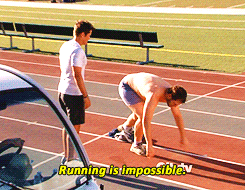Physical Activity and ExerciseIn this article we are going to answer several questions: -What is physical activity? -What is exercise? -Why is it important to know the difference? -How much of them should I be getting? When I was in college my friends and I got into an argument. I can’t quite remember how it started but I bet we were trying to rile up my roommate. He was a baseball player and if memory serves my other roommates started debating whether baseball could really be considered a sport. We started baiting him with comparisons to other sports like soccer or hockey. He countered with saying something along the lines of I’d like to see a soccer player hit a 90mph fastball. We parried with “that doesn’t make it a sport- that’s a skill.” I think there was then a comparison to golf? And it gets all fuzzy after that. I probably tuned out or left the room. The truth is we considered baseball a sport (several of the arguers were avid fans) but we just liked arguing with each other as friends do. Hell that in and of itself was like a sport. Which is precisely why this debate has remained in my memory for many years. It outlines the value of definitions and the lines we draw between things. Physical activity and exercise are similar to this. We know how necessary they are for our health, and how they have beneficial effects so many systems. Muscle health, bone health, cardiovascular, and even cognitive health are all improved thanks to regular physical activity and exercise. But how many people can really explain what they are? Hopefully more by the end. Our Language, not our philosophyThe World Health Organization defines physical activity as “any bodily movement produced by skeletal muscles that requires energy expenditure.” (https://www.who.int/news-room/fact-sheets/detail/physical-activity). That encompasses A LOT. This can be anything from Aerobic exercise to Housework to… Zebra chasing? (I don’t know if that’s actually a thing but its hard to come up with “Z” activities and chasing a zebra is definitely physical activity). So what’s the difference between physical activity and exercise? Physical activity is the broad “umbrella” category that exercise falls under. It’s like of like how apples fall under the category of “fruit” or how “Con Air” falls under the category of “Nicholas Cage movies I love to hate on” So what is exercise? Exercise is “planned, structured, and repetitive” (Caspersen et al., 1985) as well as has an intention or objective to it. It’s a little bit like a square and rectangle. You know how a rectangle is aways square but not all squares are rectangles? Exercise is always physical activity but physical activity isn’t always exercise. This helps to a certain extent but it merits the question…. Why is this important? In my opinion, to a certain extent it isn’t. Physical activity and exercise are, to the human body, indistinguishable. Our body can’t tell the difference between one or the other; it just understands the demands you are imposing on it that it must respond to. Your body doesn’t know that you are doing front squats! It just knows that all of sudden there’s something pushing it into the floor and if it wants to stand up your body and brain need to tell your muscles to increase their force production and MOVE! Essentially exercise is, at least to some extent, a man-made construct. But, it is still an important distinction for us to make -especially when it comes to communication. Whether that is trainer to client, blog author to reader, or perhaps most importantly, translating research to public recommendation. As a trainer there’s been times where I have told clients that they don’t need to do more exercise but they should do some physical activity. When I say that to them, it’s important they know what I mean. I also believe this is particularly important in this age of social media where information is plentiful and terms get thrown around carelessly. "This is particularly important in this age of social media where information is plentiful and terms get thrown around carelessly.” So we’ve learned the distinction really has more to do with language and communication than it does with identifying biology. As a result, we see that the definition is somewhat lacking. To illustrate my point I offer the following two examples: 1. Marcy says she intends to improve her aerobic fitness (objective and intention) and makes a plan to walk 1 mile every day (planned, structure and repetitive). Meanwhile Jane starts going on relaxation walks at work every day at lunch that end up being about a mile (give or take). 2. Amy starts doing step class and does a 20 minutes workout where she does 100 reps of steps. Meanwhile, Fiona decides to start walking up the stairs at her office every morning and evening totaling 100 reps of steps a day as well. In both of these examples is one getting physical activity and the other getting exercise? Are they both exercising? Are they both just being active? According to the definitions of physical activity and exercise, Marcy and Amy fit the parameters of exercise while Jane and Fiona only fit the description for physical activity. By DEFINITION they are different however, they have essentially the same PHYSIOLOGICAL toll. How do we resolve this? It outlines a new problem… Enter: The objectiveThe problem now is that between these terms there is nothing operational about them. This is a problem because it doesn’t necessary outline an operational component. So while it matters that we are able to communication these ideas, our communication is limited. And this matters very much. It matters because it does not direct people to utilize the correct actions. The correct actions being the techniques one is using to get where they want to go: Their objective! When it comes to meeting your objective, we have to match the method to objective. Essentially, are you using the right tools for the right job? To use a literal analogy: Imagine starting to build an Ikea chair, opening the box and realizing they gave you the wrong size Allen wrench! You could potentially use the one they gave you as best you can. Or try to use your fingers or some other tools to do it but no matter what, it’s probably not going to work out that well and the chair won’t really be a useable chair. Exercise is a little bit the same way. Going back to our example of Jane and Marcy. Let’s say Marcy wants to switch her current “aerobic fitness improvement plan” to something like “run a 5k.” All of a sudden we have to take a look at her plan. Walking 1 mile a day is no longer going to be the right tool- we have to change Allen wrenches. So Marcy starts a running program. Slowly building up from walking to running and increasing mileage, etc. Now her method is matching her objective. Even if its tough... There are so many reasons that people get into fitness and thus so many objectives. It would be impossible to discuss all of them....But we’ll try HERE. And as for the methods, well that is the heart of exercise programming so we’ll be discussing them HERE. But there is one last burning question... How much physical activity and/or exercise (Whatever you want to call it at this point) should I be getting?As stated above, that depends on what exactly you are trying to accomplish. Some requirement larger amounts and others less. However there are minimums recommended for ALL people.. The American College of Sports Medicine (ACSM), (https://health.gov/sites/default/files/2019-09/Physical_Activity_Guidelines_2nd_edition.pdf)) as well as many other health organizations, have outlined and promoted several standards. The recommendations for adults (18-65 y/o) boil down to:
What counts as moderate or vigorous intensity? Well, as discussed many activities fall under the umbrella of physical activity. In order to determine what counts we need to examine the intensity of the activity itself as well as how intense you the individual are performing that activity. There are so many possibilities here that there is actually a database to look them up in here: https://sites.google.com/site/compendiumofphysicalactivities/home). However to give you a better sense of what it feels like for you personally I would try a little experiment with walking. The ACSM and CDC describes moderate intensity walking as that which is 2.5mph or greater which is essentially “brisk walk pace.” They also describe vigorous walking as starting at 5.0 mph (both of these on a level surface; an incline increases the intensity). Therefore if you want to get a sense of what the bare minimum for each is: hop on a treadmill, set the pace and notice the cadence and strain during these different intensities. This will give you a subjective sense of how to rate what counts as which for you. As for resistance training, we’ll get into the specifics of that in a different article HERE. But for now just know that you should take at least 2 days per week to use those muscles! Bringing it all together:
0 Comments
Leave a Reply. |
Evan Lawrence LMHC, CPT, RYT200Write something about yourself. No need to be fancy, just an overview. ArchivesCategories |



 RSS Feed
RSS Feed